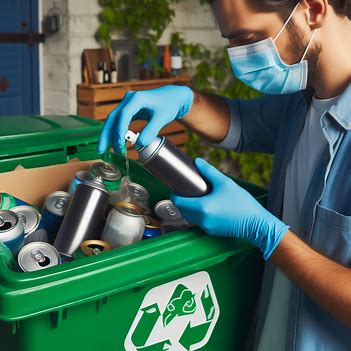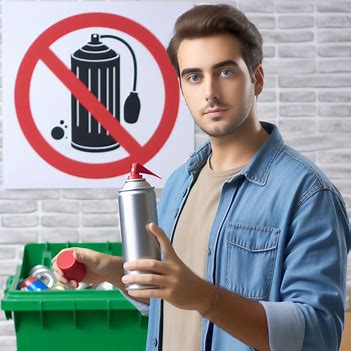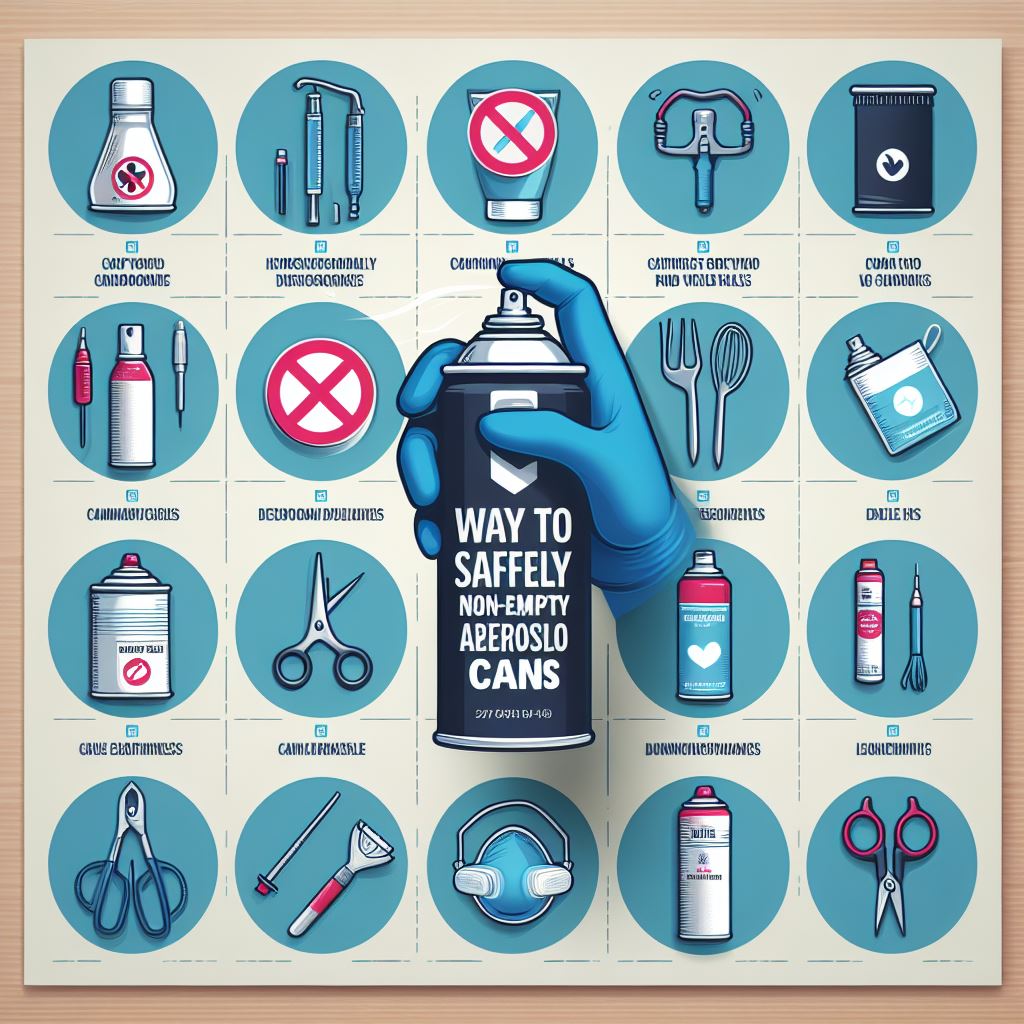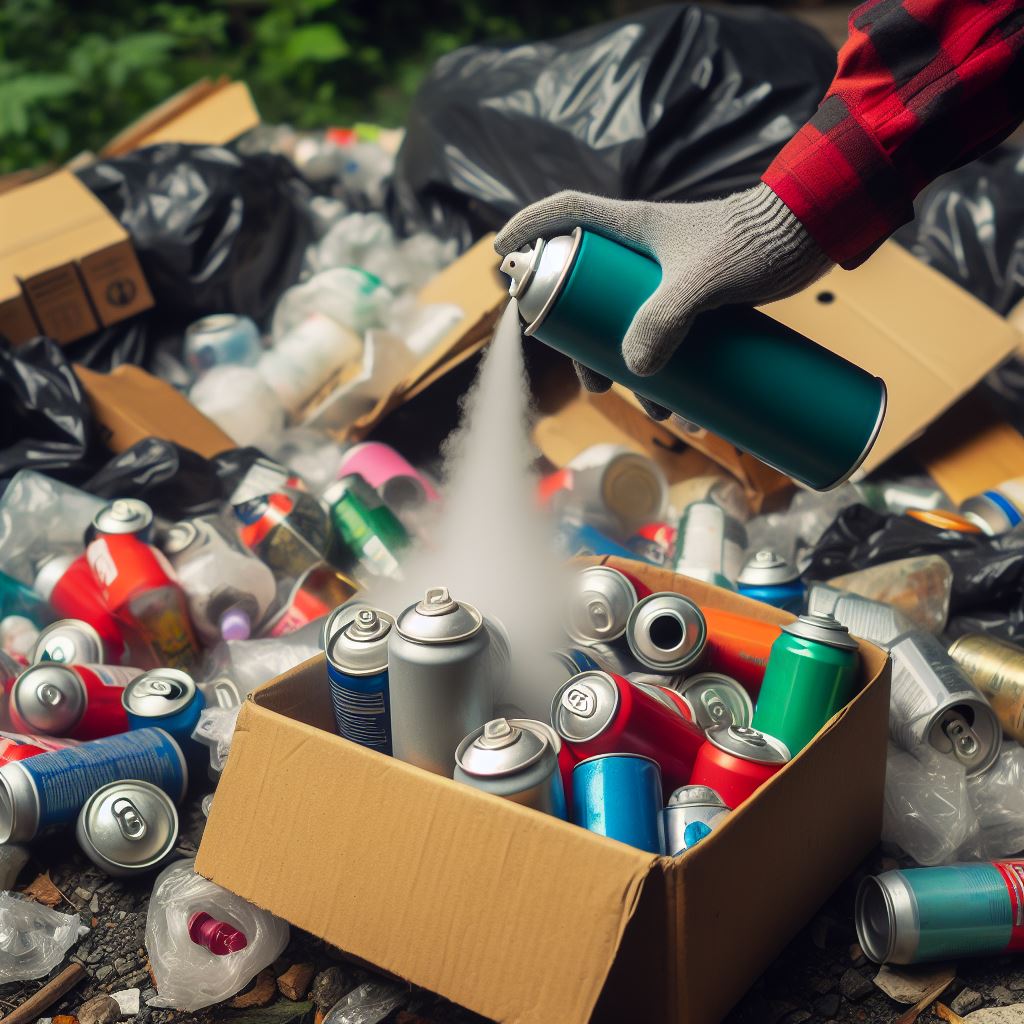- Home
- How to Dispose of Household Hazardous Waste
- How to Dispose of Aerosol Cans That Are Not Empty
How to Dispose of Aerosol Cans That Are Not Empty: A Comprehensive Guide
Knowing how to dispose of aerosol cans properly is crucial because these cans contain hazardous materials like gaseous propellant, which can be dangerous if not handled correctly.
Aerosol cans, whether it's your bug spray or aerosol spray paint, are part of our everyday lives, but when they're not empty, they become a challenge for disposal. It's important to understand that these cans, due to their compressed gas, should not be thrown in your regular household waste or recycling bin without proper preparation.
An aerosol can is defined by its ability to dispense a product as a spray, using a compressed gas as a propellant. This makes the can a pressurized container, which can pose risks if punctured or exposed to high temperatures. Therefore, safe disposal practices are essential to prevent accidents and environmental harm.
The proper disposal of these cans involves ensuring they are empty before recycling. However, for cans that still contain product, specialized disposal methods are necessary to safely puncture aerosol cans and handle the remaining contents. Your local waste service provider can offer guidance on how to proceed, ensuring that you adhere to safe disposal practices and regulations.

Understanding Aerosol Can Disposal
Disposing of aerosol cans involves understanding the nature of the hazardous materials they contain, including gaseous propellant. The process is more complex than disposing of regular waste because these cans are pressurized and can explode if treated improperly. Recognizing the right way to dispose of aerosol cans ensures safety and compliance with environmental standards.
1. Identifying Hazardous from Non-Hazardous Aerosol Cans
When you prepare to dispose of aerosol cans, it's vital to differentiate between hazardous and non-hazardous types. This distinction affects how the cans should be handled. Hazardous waste regulations classify certain aerosol products as hazardous due to their chemical composition. Proper identification ensures that hazardous cans are processed in a way that minimizes environmental impact and adheres to legal requirements.
2. The Importance of Proper Disposal for Non-Empty Aerosol Cans
Proper disposal of non-empty aerosol cans is essential to prevent harm to the environment and human health. These cans contain chemicals that can be dangerous if released into the atmosphere or left in landfills. Ensuring that you follow the correct disposal methods helps in reducing pollution and conserving resources.
The Risks of Flammable Hazardous Waste
Flammable hazardous waste, such as certain aerosols, poses significant risks. According to the California Code of Regulations, Title 22, Section 66261, improperly disposed of flammable materials can lead to fires or explosions. This underscores the importance of following regulations and guidelines for disposing of hazardous wastes, including consulting with a metal recycler when appropriate.
3. Legislation Impacting Disposal Practices
Legislation plays a key role in shaping disposal practices for aerosol cans. Laws and regulations ensure that the disposal process protects the environment and public health by setting standards and guidelines for handling and disposing of these items.sm
B 1158 – Aerosol Cans as Universal Waste
SB 1158 categorizes certain aerosol cans as universal waste, highlighting the need for special handling to prevent flames and other ignition sources from causing harm. This legislation acknowledges that cans could corrode or suffer physical damage, leading to environmental hazards. It sets forth guidelines for safer disposal practices, emphasizing protection against potential risks.
Preparing for Disposal
Before disposing of non-empty aerosol cans, it's important to prepare them correctly. This involves understanding the waste generated and the specifics of hazardous waste disposal. Following the Health and Safety Code and ensuring that cans made of steel or aluminum are ready for processed disposal are crucial steps.
1. Steps to Safely Handle Non-Empty Aerosol Cans
Handling non-empty aerosol cans safely requires attention to detail. You should have clear questions in mind regarding the type of waste generated and the appropriate methods for hazardous waste disposal. This knowledge helps in preventing accidents and ensuring that the cans, whether steel or aluminium, are processed correctly.
How to Determine If Aerosol Cans Are Empty
To determine if an aerosol can is truly empty, listen for the absence of sound when you shake it and check for any remaining propellant release when the nozzle is pressed. An empty can will not emit any product or propellant. This step is crucial in deciding the next steps for disposal or recycling.
2. Storage Tips for Unwanted Non-Empty Aerosol Cans
When storing unwanted non-empty aerosol cans, it's essential to consider the regulations in the United States regarding accumulation or transportation. Storing cans properly minimizes risks and ensures compliance with disposal guidelines
How to Store Your Unwanted Non-Empty Aerosol Cans Until Disposal
To store your unwanted non-empty aerosol cans safely, keep them away from flames and other ignition sources. Be aware that cans could corrode or suffer physical damage if not stored properly. Taking these precautions helps in preventing accidents and environmental damage.
Disposal Methods for Non-Empty Aerosol Cans

The disposal of non-empty aerosol cans should aim to recover the propellant to the maximum extent practical. Programs like DTSC’s household hazardous waste initiatives provide avenues for disposing of items like spray paints safely and responsibly.
1. Recycling Programs and Aerosol Can Recycling
Recycling programs play a crucial role in managing household hazardous waste, including aerosol cans from products like whipped cream. These programs ensure that generators of hazardous waste have a responsible way to dispose of metal cans, contributing to environmental sustainability.
Find a Local Recycling Program Near You
Finding a local recycling program for household hazardous waste is a vital step in responsibly disposing of aerosol cans. These programs provide the infrastructure and guidelines needed to ensure that aerosol cans are recycled in a way that minimizes harm to the environment.
2. Using Aerosolv® for Aerosol Can Disposal
When you're dealing with aerosol cans that aren't empty, it's crucial to handle them carefully to avoid accidents and environmental damage. Aerosolv® is a specialized puncturing device and recycling system designed for this purpose.
It safely punctures aerosol cans, allowing for the remaining contents to be processed and the cans to be recycled. This system not only helps in managing hazardous waste treatment effectively but also ensures compliance with EPA regulations. By using Aerosolv®, you can dispose of waste responsibly, treating aerosol cans as a universal waste and avoiding the risks associated with disposing of aerosol cans in the trash.
Aerosolv 5000 Recycling System
The Aerosolv 5000 recycling system is an advanced solution for businesses and facilities looking to dispose of their aerosol cans efficiently. This system allows you to puncture and drain cans safely, capturing the residual contents in hazardous waste containers. It's designed to operate to the maximum extent practical under normal conditions, ensuring that processed aerosol cans are ready for recycling.
The Aerosolv 5000 system is not only easy to use but also helps your business comply with strict environmental regulations, making it a smart choice for eco-conscious entities.
Aerosolv360 Aerosol Can Recycling for High-Volume Producers
For organizations producing a large volume of aerosol waste, the Aerosolv360 offers an effective recycling solution. This high-capacity system is tailored for high-volume producers, ensuring that the disposal process is streamlined and efficient.
By converting hazardous aerosol cans into recyclable metal, the Aerosolv360 system minimizes waste and aids in hazardous waste treatment. Its robust design and capability make it an essential tool for industries seeking to manage their aerosol can disposal responsibly while adhering to EPA regulations and reducing their environmental footprint.
Environmental Impact and Safety

Disposing of aerosol cans properly is not just a regulatory requirement but a critical step in protecting our environment and public health. Incorrect disposal can lead to pollution and hazardous situations. Recycling aerosol cans reduces the demand for raw materials, lessens waste in landfills, and lowers the risk of contamination and explosions. It's essential to follow safety guidelines and use appropriate systems like Aerosolv® to ensure that aerosol cans are disposed of in a way that minimizes environmental harm and maximizes safety for everyone involved.
1. The Role of Recycling in Minimizing Environmental Harm
Recycling plays a pivotal role in our efforts to safeguard the environment. By recycling aerosol cans, we can significantly reduce the amount of waste sent to landfills and decrease the need for new raw materials. This not only conserves resources but also lowers greenhouse gas emissions associated with manufacturing new products.
Proper recycling processes ensure that hazardous materials are handled correctly, reducing the risk of soil and water contamination. Embracing recycling is a step towards sustainable living, demonstrating our commitment to preserving the planet for future generations.
2. Safety Precautions When Disposing of Aerosol Cans
When disposing of aerosol cans, safety should always be your top priority. Ensure that cans are empty before disposal, and never attempt to puncture or crush them yourself unless using a device like Aerosolv® designed for this purpose.
Store unwanted aerosol cans in a well-ventilated area away from direct sunlight and heat sources to prevent accidental explosions. Always follow local regulations and guidelines for hazardous waste disposal, and consider recycling whenever possible. By taking these precautions, you can help prevent accidents and environmental damage.
Resources and Further Assistance
Finding reliable information and assistance for aerosol can disposal can be challenging, but several resources are available to help. Whether you're looking for guidance on recycling programs, want to understand regulations better, or need advice on handling hazardous waste, reaching out to the right sources can make the process smoother and more effective. Start by consulting local environmental agencies and waste management organizations, as they can provide specific instructions and recommendations based on your location and needs.
1. Where to Find More Information
For those seeking more in-depth information on aerosol can disposal, the internet offers a wealth of resources. Websites of environmental protection agencies, waste management organizations, and recycling centers often have detailed guidelines and tips on how to dispose of aerosol cans responsibly. Additionally, manufacturers of disposal systems like Aerosolv® provide comprehensive instructions and support for their products, ensuring you can use them effectively and safely.
U EPA and External Resources
The United States Environmental Protection Agency (EPA) is an invaluable resource for understanding the regulations and best practices for disposing of aerosol cans. Their website offers detailed information on hazardous waste management, recycling programs, and how to comply with federal guidelines.
Additionally, external resources such as environmental advocacy groups and professional waste management organizations can provide further assistance and advice, helping you navigate the complexities of aerosol can disposal while minimizing environmental impact.
2. Contact Information for Regulatory Assistance
If you're unsure about the best way to dispose of your non-empty aerosol cans, help is available. The United States Environmental Protection Agency (EPA) is a valuable resource for understanding federal guidelines and can provide you with the necessary information to dispose of aerosol cans responsibly.
Your state's environmental protection agency or local waste management authorities can also offer guidance tailored to your region's regulations and available resources. Don't hesitate to reach out to these organizations for assistance in ensuring your aerosol can disposal methods are safe and compliant with current laws.
Conclusion: Ensuring Safe and Responsible Disposal of Aerosol Cans

Ensuring the safe and responsible disposal of aerosol cans is critical to protecting both the environment and human health. Aerosol can disposal, when not handled properly, poses significant risks due to the hazardous characteristics of the contents.
With legislation like SB 1158 allowing businesses to process the cans on-site without a permit or other authorization from DTSC, it's easier than ever to manage aerosol cans as hazardous waste responsibly. This not only simplifies compliance but also encourages the adoption of environmentally friendly practices.
However, it's vital to remember the importance of using the right tools and procedures, such as an activation wheel and an anti-static ground wire, to safely dispose of aerosol cans. These tools ensure that the cans are processed safely, preventing accidents and environmental harm.
By following these guidelines and taking advantage of available resources and recycling programs, you can contribute to a safer, cleaner environment. Remember, every effort to dispose of aerosol cans responsibly makes a difference.